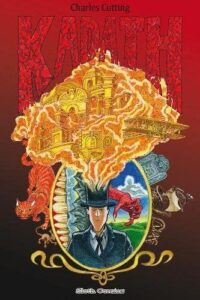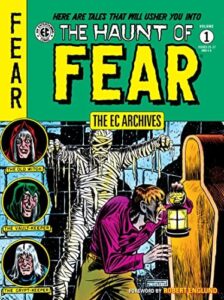
American Cult edited by Robyn Chapman
Silver Sprocket, 2021
ISBN-13: 978-194550963
Available: Paperback ( Bookshop.org | Amazon.com )
American Cult is a graphic history of American religious cults dating from colonial America to the present. According to editor Robyn Chapman, the eighteen pieces in American Cult turn a critical eye to the cults and their behavior, but recognize the very human faces that entered into these dangerous groups.
The book opens with “The Monk in the Cave” by Steve Teare, relating the history of mystic Johannes Kelpius, also called the “Wissahickon Wizard”, who led the Society of the Woman in the Wilderness in Philadelphia in the 1690s. “Inside Oneida” by Emi Gennis addresses the eugenics experiment that the founder, John Humphreys Noyes, demanded of his followers and the incestuous relationship Gennis carried on with his niece, Tirzah, and how it affected her in her own life. In “Fruitlands: The Little Cult that Couldn’t”, Ellen Lindner relates the Alcott family experience and a failed experiment had a profound effect on Louisa May Alcott’s adult life. “Children of God!” by Rosa Colón Guerra presents the case of sexual abuse ran rampant in this cult at the behest of the leader, David Berg; Ricky “Davidito” Rodriguez, a child of the cult leader and also a victim of abuse, later as an adult found one of his abusers as an adult, killed her, and then killed himself. The cult still exists as a Christian church.
“Death Valley ’69” by Janet Harvey and Jim Rugg discuss the Manson Family. There wasn’t anything really new came out of this, but what volume wouldn’t be complete without mentioning one of the most famous American cults? In “Source Family Values”, Andrew Greenston discusses the Source Restaurant and how easy it was for them to garner followers. “Mindbending: A Story about the Process Church of the Final Judgment” by Lara Antal shows further subtle ways a cult can lure in someone. “Cults Reoriented” by Josh Kramer and Mike Dawson discuss Sufism Reoriented (SR), a cult comprised of white, wealthy Baby Boomers located in Walnut Creek, CA, and its connection with The Cheesecake Factory. In “Walk a Mile in My Shoes: A Jonestown History” by Ryan Carey and Mike Freiheit outlines Jones’ time leading up to the establishment of Jonestown, subsequent travel to Guyana, the physical and psychological torture he put followers through, and the mass suicide or murder that ultimately resulted; the narrative is told through a faceless member of Jones’ congregation, and the last two pages make some profound statements. “Playing the Game” by Lisa Rosalie Eisenberg discusses Synanon, tracing the history through Synanon III, or the Church of Synanon, all the way to the cult’s demise. The author ties the “troubled teen bootcamps” to Synanon.
“MOVE” by Ben Passmore presents the rise and fall of MOVE founder John Africa. The police aren’t shown in a good light here, either, considering after the death of a police officer they arrested nine members of the group after a standoff and the courts convicted them, even though no evidence supported the decision. Police also used C-4 to burn a building MOVE members were hiding in, and killed all but two.
“That’s Not What We’re Called” by Jesse Lambert focuses on Sullivanians and modern day effect on offspring of the adults involved in the sex cult. “The Last Days of Mount Carmel” by Vreni Stollberger, told in second-person, regards the Branch Davidians and the ATF/FBI raid that ended in tragedy. “Making Sense of Heaven’s Gate” by Robyn Chapman includes something particularly touching in the 2-page visual obituary of the victims of the mass suicide. Instead of just leaving them as the faceless covered bodies wearing jumpsuits and sneakers, we see the smiling faces of those who died believing they were being taken to the heavens.
“God Hates Me: A True Tale of the Westboro Baptist Church” by J.T. Yost, is told by the child of a parent who was converted by the WBC, and is particularly difficult to read. “Keep Sweet: On Warren Jeff and His Mormon Fundamentalist Splinter Group” by Robert Sergel presents the disturbing history of the FLDS. “Orthodox Judaism is a Cult” by Lonnie Mann provides a firsthand account of growing up as an Orthodox Jew in New York. He discusses his falling out with his religious parents, and how his life changed for the better after accepting himself. “Call Me Vanguard” by Brian “Box” Brown presents disturbing practices and initiation of NXIVM members.
Chapman outlines very well-defined criteria used to determine if a group is a cult. Regarding the content, Chapman states, “When it comes to creating this sort of nonfiction, I feel you should approach these stories with 50% empathy and 50% justice”. She and the other contributors to American Cult create this balance well. There is a particularly eye-opening sentiment that brainwashing doesn’t just effect the gullible. The chapter on Westboro Baptist Church by J.T. Yost illustrates this frighteningly well. I would recommend this for readers who want a deeper look into these cults. Recommended.
Reviewed by Lizzy Walker
 0
0





Follow Us!